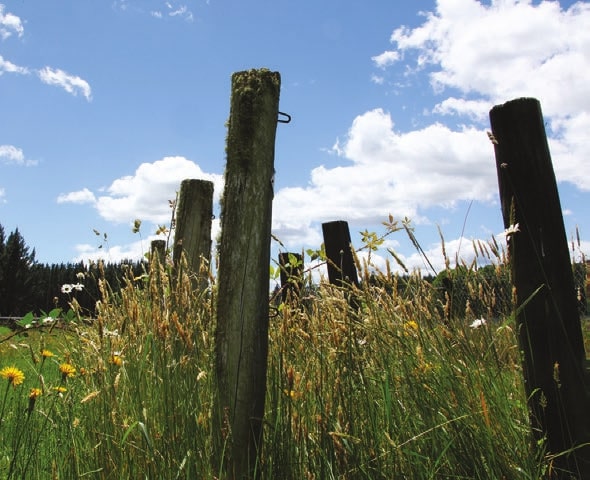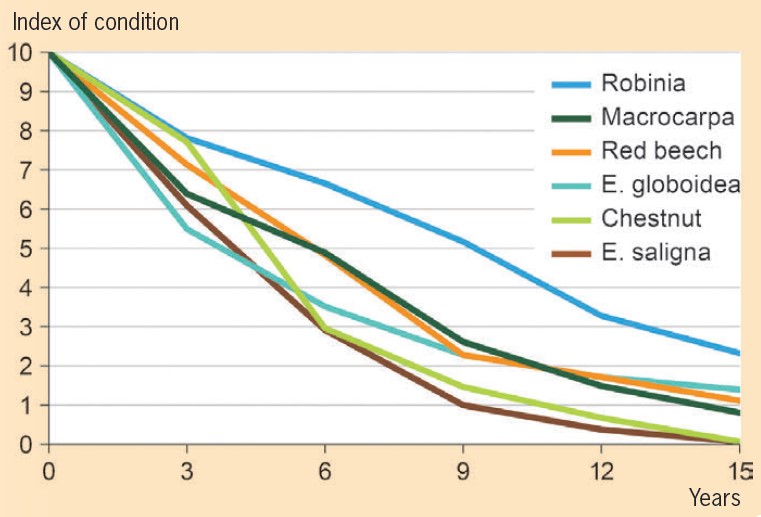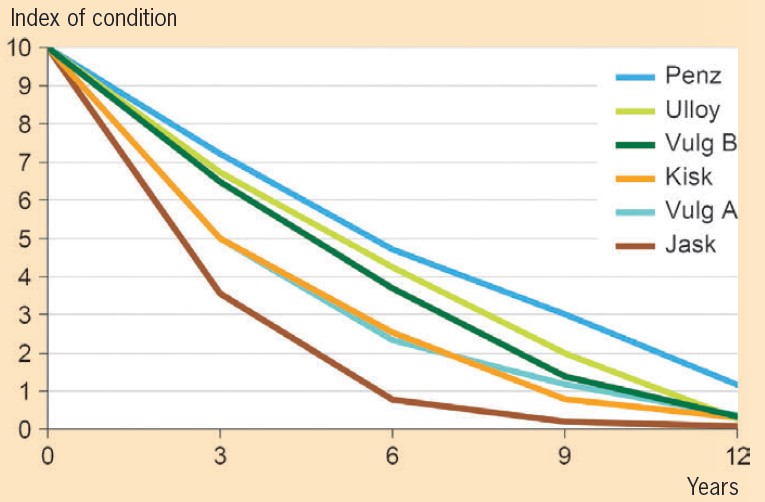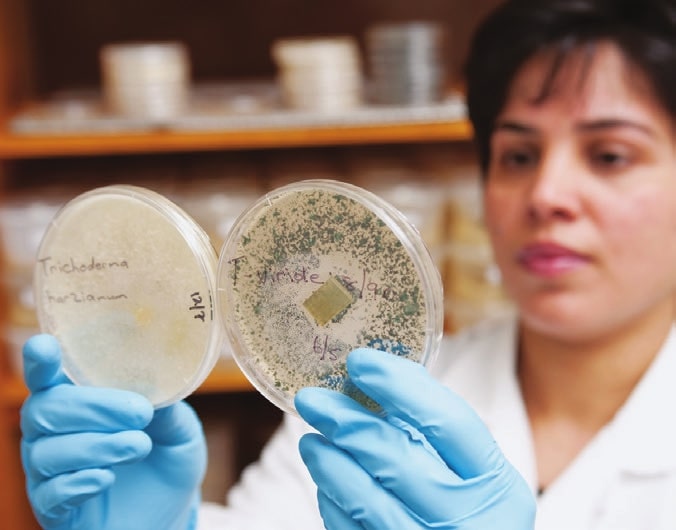Stop the rot - durable wood
Michelle Harnett, Dave Page and Nick Ledgard, New Zealand Tree Grower February 2017.
Every good forestry research institute needs a graveyard. The wooden stakes in Scion’s graveyard are not marking the last resting place of ancient foresters. They are part of long running tests to evaluate wood durability.
Examples of wooden stakes, poles, posts, cladding and decking have been buried in the ground, propped up on bearers and exposed to the elements at the Whakarewarewa site since about 1940. The graveyard allows wood and wood products to be field tested where there is a high decay-hazard over a long time.
The Whakarewarewa graveyard is one of four around the country. Each of the sites poses different environmental challenges. Rotorua air is acidic and full of sulphur. The soil at Glenbervie near Whangarei is wet clay. The site near Waiterere Beach close to Levin is wet and sandy while the Hanmer site is dry and stony. The last three are ex-Forestry Service sites now in private hands.
Graveyard testing is the ultimate test of durability, according to Tripti Singh, a scientist who specialises in wood preservation research at Scion. The long-term effectiveness of a new timber treatment, or the performance of natural durable species such as totara, can be gauged after long term contact with soil. Many of the current wood preservatives and New Zealand-grown naturally durable timbers have been tested in Scion’s graveyard and are now included in New Zealand standards for the chemical preservation of timber and for timber used in building.
The graph shows example of results obtained from stakes, which are only 20 by 20 mm in size, from different species tested together in the Scion Rotorua graveyard. The durability different index of condition is the average rating for all of the specimens in a group where 10 means the timber is sound and zero means a failure.


What rot
Wood decay is a natural process which allows the nutrients contained in wood to be recycled. While this is desirable in a forest, it is not so good when a fence post fails, or your barbeque guest falls through the deck.
Rot is caused by fungi which secrete enzymes and other chemicals that destroy different components of wood. White rots break down lignin and cellulose resulting in white, moist and spongy looking wood. Brown rots break down cellulose and hemicellulose. This process also produces hydrogen peroxide which diffuses through the wood leading to decay not directly related to the fungus. The decay caused by the hydrogen peroxide causes the wood to shrink and crack into rough cubes. Dry, crumbly-looking brown rot is sometimes wrongly called dry rot, but this is a misnomer – all rot is caused by the presence of moisture.
Insects also pose a threat to wood. New Zealand is fortunately free of termite species which chew their way through houses. Species of native termites are very rarely found outside forests.
Defining durability
Living trees have several lines of defence against fungi bark, sapwood then the heartwood. Stem decay fungi cannot infect a tree through intact bark. Sapwood cells can respond to an invasion via a ‘doomsday’ response in which some cells kill themselves in the presence of fungi resulting in conditions which are unfavourable to fungal growth. In conifers, resin can be piped in to seal off an infected area. The xylem can also react to wall-off an invader.
| Natural durability class | 1 Very durable |
2 Durable |
3 Moderately durable |
4 Non-durable |
|---|---|---|---|---|
| In the ground | Over 25 years | 15 to 25 years | 5 to 15 years | Less than 5 years |
| Above ground | Over 40 years | 15 to 40 years | 7 to 15 years | Less than 7 years |
| New Zealand grown timber examples | Totara, silver pine, Eucalyptus cladocalyx | E. globulus, E. pilularis, red beech, hard beech, mountain beech, oak | Black beech, rimu, matai, kauri, macrocarpa, redwood, E. fastigata, E. dobliqua | Poplar, tawa, Corsican pine |
When it comes to timber, only the heartwood is durable – sapwood, regardless of tree species, is not durable. Natural durability is rated on timber performance in contact with the ground and above-ground. Durability in New Zealand is measured using the Australasian classification AS 5604-2003, which classifies timber into the four classes shown in the table above.Heartwood is different. As a tree grows, chemical compounds, called extractives, are deposited into the cells in the centre of the stem. Many extractives are bioactive, with antimicrobial, antifungal or insect repelling or killing properties. When these cells die and form heartwood the extractives contribute to an environment which is inhospitable to fungi.
There can be considerable variability within species, with durability affected by genetics, growing conditions, climate and wood age. In-service conditions vary too, which is where the value of having graveyards with different soil and climatic conditions comes in.
Proving and improving wood durability
The solid wood processing team at Scion focuses on assessing and improving the durability of timber. Tripti Singh and her team work with industry locally and internationally, testing the durability of wood products and setting and reviewing standards for good building practices. They are also investigating ways to expand opportunities for using wood products by improving durability. This includes developing new preservative systems and new wood processing technologies.
An active area of research is looking at alternative treatments that could replace current preservatives such as chromated copper arsenic, known as CCA, which is used extensively to increase the durability of radiata pine. The chromium binds the copper, which protects against decay and bacteria, and the insecticidal arsenic component, to the wood cellulose and lignin. CCA is very effective, but disposing of CCA-treated wood in New Zealand means either sending it to controlled landfill sites or incineration in an appropriate facility. In many countries, the use of CCA-treated timber is restricted due to the toxic elements involved, particularly for residential applications. A preservative to replace CCA would benefit the environment and help ensure market access for exports.
Heartwood hints
Extractives from durable heartwood are known to protect the timber from fungal and insect attack. Black locust or Robinia pseudoacacia is an excellent example of this. Researchers from Mendel University in the Czech Republic extracted a range of compounds from black locust heartwood. After non-durable European beech was impregnated with the extracts the wood’s durability class increased to moderately durable.
The Scion team have looked at heartwood extractives as part of their search for effective new preservatives with low or no toxicity. They have also considered bioactive extractives from other sources, including agricultural and horticultural waste, essential oils, medicinal and native plant extracts, natural biocides and compounds generally recognised as safe, such as food preservatives.
The extensive screening programme has identified a number of potential compounds. The process starts in the laboratory in petri dishes where the inhibition or not of fungal growth in the presence of different materials is observed. More than 20 compounds with anti-fungal properties have been identified.


Two possibilities
Identifying active compounds is the first step in the process. This is followed by the development of a water-based formulation containing the active compound which subsequently has to impregnate timber and, most importantly, not leach out again.
To date, two compounds have successfully passed through the series of laboratory trials. The most promising is now being evaluated in cladding, decking and exterior joinery in long-term field trials in the Whakarewarewa graveyard and the Oregon State University’s graveyard in Hawaii where termites are present. The field trials are being assessed yearly. The team have also come up with a method of quantifying the novel bioactive in treated wood for quality assurance purposes.
The screening work has taken around five years. Identifying new wood preservation candidates is likely to be much faster in the future. Genome sequencing is becoming more and more common as costs decrease and the available computing power which is needed increases. Genomes can be ‘mined’ or searched for DNA sequences known to code for enzymes associated with particular bioactive compounds.
Investigating technology such as supercritical carbon dioxide extraction to remove water and impregnate wood with potential preservatives is also part of the research programme. Introducing new compounds into wood cells is comparatively easy – the hard part is ensuring they do not leach out when the wood gets wet. Possible solutions to the problem include binding the preservative directly to cellulose or lignin, or attaching a second chemical or polymer to the preservative that can bind to wood components.
Moving from adding active components to wood, an alternative approach to increase wood durability is to modify the structure of the wood. This can be done simply by heating wood in the absence of oxygen.
This causes permanent physical changes that prevent the wood cell walls and interiors from absorbing and holding water. Other chemical-based ways to modify wood structure were outlined in the November 2016 issue of Tree Grower.
Naturally durable woods in New Zealand
A number of native and exotic timbers grown in New Zealand are naturally durable. A classic example is totara, which was widely used by early European settlers for piles and fence posts, many of which are just beginning to fail now after more than 100 years of service.
Naturally durable timbers can be an alternative to preservative treated timbers such as radiata pine. An obvious group to explore are the eucalypts, some of which fall into durability class 1 or 2. The New Zealand Dryland Forests Initiative is working to identify and develop ground-durable eucalypt species for dry regions. They have selected the following as their focus for tree improvement work −
- Eucalyptus argophloia − western white gum
- Eucalyptus bosistoana − coast grey box
- Eucalyptus globoidea − white stringybark
- Eucalyptus tricarpa − red ironbark
- Eucalyptus quadrangulata − white-topped box gum.
These species were chosen for their durability, fast growth, stiffness and strength properties, resistance to drought, frost tolerance and established timber potential based on Australian experience. A number of alternative species are included in New Zealand building standards. They provide niche opportunities not open to radiata.
Along with natural durability comes attractive appearance and good regional or heritage stories, especially with indigenous species. With wider potential applications and options leading to more certain markets, planting other species is likely to be more financially attractive to owners of small to medium forests as well as larger forestry concerns.
The new preservation and other technology that Scion is developing will allow the wood processing industry to move to manufacturing and exporting technologically differentiated and high-value materials. New research on naturally durable timbers will also help develop niche markets for alternative species, making planting and growing them more attractive. None of the work would be possible without graveyards, suggesting we should look at them with new eyes – not dead history but the future of the timber industry.

 Farm Forestry New Zealand
Farm Forestry New Zealand


2 posts.
Post from John and Rosalie Wardle on March 1, 2017 at 9:16PM
I read with interest your article in the February 2017,Tree Grower, headed ‘Stop The Rot-Durable Wood’.
There is little doubt that the graveyard tests described can be of great value, but unfortunately unless specific information is available relating to the origin of the test material, there can be misappropriate interpretation and this can be quite dangerous when it comes to seeking resource consent for buildings, bridges etc.
The authors appropriately state that there can be considerable variability within a species with durability
affected by genetics, growing conditions, climate and wood age. However, no allowance is made for this variability in the tables which relate species to single durability classes.A species, regardless of its likely variability, is relegated to one specific durability class.
Redwood provides a good example. It has been defined in the article as being moderately durable, lasting only 5-15 years in the ground and 7-15 years above ground. It is well known that provenance and durability in redwood are strongly linked, with redwood of some provenances lasting much longer than this, so unless different provenances can be stated, the table is of little value.
The New Zealand beeches provide a good example of how durability of the species can be related to a number of factors. Red beech, hard beech and mountain beech are all given in the table as durable whereas black beech is classified as only moderately durable. Pure red beech would normally fall into the category shown in the table although there is strong evidence that some provenances of red beech have very poor durability properties. On the other hand it is doubtful that pure hard beech would consistently fall into this class. Red and hard beech hybridise freely with each other and with black beech and it is often difficult to identify hybrid origins. Hybridisation in this case can have a considerable effect on wood durability and provide problems with categorisation.
Likewise black beech and mountain beech hybridise freely. Generally the experience has been that mountain beech has relatively low wood durability whereas black beech is variable. Black beech and mountain beech have very similar physical characteristics and often it requires an expert to distinguish between the two. Possibly the test material for mountain beech was from Southland where what is known as ‘lowland’ mountain beech has more affinity with black beech than mountain beech.
Black beech in the table is classified as only moderately durable, yet there are examples in Canterbury of black beech heartwood posts which have survived in the ground for over 100 years, and we have buildings with black beech exterior claddings which show little sign of deterioration after 40 years. Historically there has been considerable debate centred around the durability of black beech timber. It has been reported that in some instances the timber has decayed and failed within a few years when in ground contact, whereas there are other instances where it was regarded as virtually non-perishable and infinitely superior to matai and totara.This variability is almost certainly related to failure to distinguish between true heartwood and pathologically induced heartwood, originating from pinhole and associated fungal infection while still in the tree.
One other aspect not accounted for in the report on the graveyard trials is the distinction between susceptibility to fungal attack, and attack by the common house borer. The beeches, although of variable susceptibility to fungal attack depending on conditions, are, as a group virtually non-susceptible to the common house borer and in this regard are infinitely superior to rimu.This distinction is of importance in interior and above ground use.
The main objective of this letter is to highlight the dangers of placing a species in one single durability category. Unless there is some attempt to relate the range of durability of a species to variables such as provenance, heartwood class, hybridisation, old growth or young growth forests, etc., the results of the graveyard tests become meaningless and as the name suggests, they should remain buried.
John Wardle
Post from Peter Marshall on March 1, 2017 at 9:25PM
I was interested to read the article about Scion’s wood durability trials. Our family runs a sort of ‘accelerating ageing’ trial as a by-product of growing dinner.We inoculate logs with shitake mushrooms Lentinula edodes.These saprophobes colonise sapwood, yielding multiple crops of gourmet mushroom as they break down the wood.
Equal age and diameter oak, eucalypt, Robinia and beech are reduced to a white stringy pulp in three to five years.The standout durability performer is chestnut. Its sapwood is so narrow and extractives so powerful that shitake just cannot rot it.
Castanea sativa is a common pole in European vineyards. Castanea dentata was the legendary all-purpose timber of the US east coast until the terrible blight. Both were source of tannins for hard leather.
Is anyone looking at the durability of coppiced chestnut poles or extractives from nut peelings, burrs or bark? It would be interesting to hear of any examples of forest from chestnuts in New Zealand.
Peter Marshall, Reidsdale, NSW
Add a post